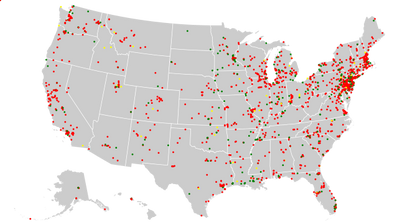We do everything from providing in-depth breakdowns of common contaminants to reports on city tap water quality. We’re keeping it going by writing about another common heavy metal that can contaminate drinking water: Arsenic.
How Are We Exposed To Arsenic?
Humans are exposed to inorganic arsenic mainly through contaminated drinking water. Some water sources in the United States have higher naturally occurring levels of inorganic arsenic than other regions. Levels of inorganic arsenic in soil typically range from 1-40mg/kg and the EPA recommended concentration in water supplies is less than 10µg/L. However, higher levels can occur near natural mineral deposits, mining sites, smelting industries, and regions where pesticides have been applied.
In addition, workers who use arsenic compounds for smelting, pesticide manufacturing and application, and wood preservation are at a higher risk for arsenic poisoning.
Below is a map published by the United States Geological Survey (USGS) which shows the concentration of arsenic in groundwater in the United States. It’s estimated that 2 million Americans have private wells and drink water with unsafe levels of Arsenic. If you live in one of the areas with high arsenic concentration, and get your drinking water from a private well, we highly recommend getting your water tested by a qualified laboratory.

Arsenic Toxicity
Arsenic is a toxic heavy metal several epidemiological studies have reported a strong association between arsenic exposure, cancer, and systemic diseases. In fact, arsenic exposure affects virtually all organ systems including the cardiovascular, dermatologic, nervous, hepatic, renal, gastrointestinal, and respiratory systems. The severity of the adverse health effects is related to both the chemical form of arsenic and the dosage. Evidence of carcinogenicity due to arsenic exposure is very strong, but the specific mechanism by which it causes cancer is not completely understood.
Recent studies have found that pregnant women are especially susceptible to the harmful effects of arsenic exposure. Arsenic exposure can drastically impact reproductive outcomes, affect fetal development, and can lead to long term health problems. However, the association between chronic arsenic exposure and adverse pregnancy outcomes is not widely recognized.
What Can I Do To Reduce My Exposure To Arsenic?
A growing number of people are realizing that regulatory limits are not always in line with current toxicological studies, and are taking steps to minimize exposure to heavy metals like arsenic, lead, mercury, and chromium 6 from their drinking water, even if their city is "in compliance" with EPA regulations.
Unlike lead, which leaches into water from pipes, arsenic comes from the source water itself, so flushing pipes or replacing plumbing will not reduce arsenic concentrations. Boiling water also does NOT remove arsenic. Arsenic must be removed using a water filter that is specifically designed to do so.
Whole House Filters
While some whole house filters can reduce arsenic levels to some extent, we don't recommend most whole house water filters due to their high cost and unnecessary filtration of water when it isn't consumed (such as flushing the toilet). Instead, we advocate for point-of-use water filters, which are more efficient and cost-effective for filtering water that is being consumed.
In cases where arsenic levels are very high and exceed our performance specifications, we may suggest considering a specialized arsenic removal filter at your home's point of entry to bring the levels within our operating parameters. Once this is achieved, you can use a Hydroviv filter at your point of use for further arsenic reduction.
Point Of Use Water Filters For Arsenic
The most cost-effective method of arsenic, chromium 6, and contaminants filtration is through a point of use water filter. When shopping for these systems, we encourage you to make sure that the filter actually filters arsenic (most don't). While we believe that our advanced under sink filters have unique benefits and use filtration media that effectively remove both types of inorganic arsenic, some systems that use reverse osmosis can be a good choice for people who are willing to accept the downsides. No matter what... make sure that your filter removes what you think it does!
As always, feel free to take advantage of our “help no matter what” approach to technical support! While we do make water filters that remove arsenic, our water nerds are happy to answer your questions about the effects of arsenic in water, even if you have no intention of purchasing a Hydroviv Water Filter. Reach out by dropping us an email (hello@hydroviv.com) or through the live chat on our webpage.
Other Articles We Think You'll Enjoy
5 Most Important Things To Know About Arsenic In Drinking WaterWhat Most People Don't Know About Well Water Quality
How Do I Filter Chromium 6 From My Drinking Water?












